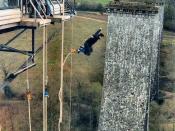Bungee jumping is a sport that has dramatically evolved over the past couple decades. Bungee jumping has evolved into a sport of art and thrill. As a tribal tradition, the ritual was soon incorporated with a bungee cord. Bungee jumping spread rapidly throughout the world, ever-growing in popularity. Detailed designs and engineering have helped to take bungee jumping to all new limits. An array of prices depicts a variety of heights, harnesses, and locations of sites. Bungee jumping offers many diverse medical advantages. New innovations in the bungee field have led to all new rides and adventures. Bungee jumping is a sport that enables a person to prove something to themselves, regardless of age, sex, religion, or race.
Bungee jumping is based on an age-old ritual practiced by the "land divers" of Pentecost island in the South Pacific archipelago of Vanuatu. Young men proved their courage by plummeting off giant towers.
Every spring villagers there collect liana vines and wind them into long cords. The men then scale six story wooden towers, attach the vines around their ankles and jump. A successful leap is considered a demonstration of courage. In 1979, a bungee cord was incorporated with this tribal ritual. Members of the Oxford University's Dangerous Sports Club read about and designed a safe form of the practice. Atop the Golden Gate Bridge, dressed in tuxedos and top hats, the first form of bungee jumping came to existence. In 1987, bungee jumping moved to the American commercial scene. Two brothers, John and Peter Kockelman, began jumping from bridges over river gorges in the Sierras. Recognizing the sport's commercial potential, they opened Bungee Adventures in 1988.
Bungee jumping spread rapidly throughout the world, ever-growing in popularity. Bungee jumping became national crazes in many areas. After the use of a bungee cord...


